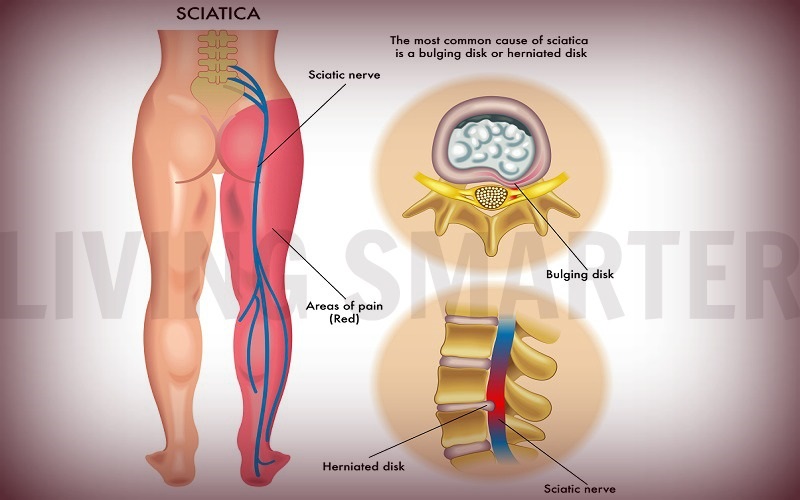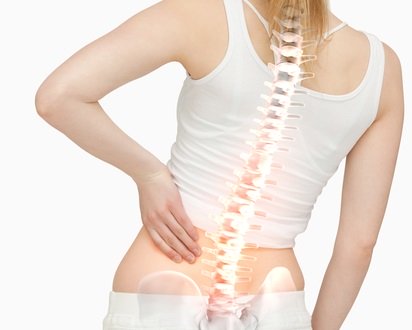Fibromyalgia and
Sciatica Pain –
Can one affect the other?

Sciatica pain and fibromyalgia often coexist in the same person but may require different treatments and pain management options.
Fibromyalgia itself is known for causing pain in various regions of the body. Many of us living with fibromyalgia may also have secondary diagnoses when symptoms overlap with other conditions.
As complex as fibromyalgia is, we don't want to miss other conditions that may need separate attention.
Sciatica is one of the most common conditions to coexist with fibromyalgia. In this case, one condition doesn't necessarily cause the other... they can simply exist together, but either way, all fibromyalgia patients should know what sciatica pain is all about.
Sciatica versus Piriformis Syndrome
Some people with sciatic pain will often report having pain around the hips, buttocks, and down the legs. It might take some investigating from your attending therapist to find out exactly what you are dealing with.
Because wait..hold up... you may also have piriformis syndrome, and not sciatica.
Where sciatica is more related to the spine and lower back, piriformis is a deeper pain inside the medius of the buttocks, and although it can still radiate pain, it radiates differently than sciatica.
Piriformis Syndrome creates more of a deep internal pain around the buttocks and hips.
This can occur when the piriformis muscles in the buttocks get irritated near the sciatic nerve.
I have found that we cannot pattycake when it comes to working with piriformis syndrome. Regular stretching and rolling on a foam roller or ball just don't often get it. I discovered that I can get rid of piriformis pain quicker than I ever could before.
We have to be willing to go a little deeper because the pain itself is a very deep internal pain. I address this on our fitness page as well. Fibro Fit People.
Try to be as consistent as possible with very gentle stretches and holds. Never stretch too far or too quickly. I often say that "conventional stretching is not always appropriate with fibromyalgia" Some of these are shown in the hip flexor article.
Understanding Sciatica Pain
Sciatica is a medical condition that produces pain along the sciatic nerve. For most people, the pain starts on one side of the buttocks and travels down the back of the leg. In some cases, other symptoms may present in the leg, including:
- Tingling
- Burning
- Numbness
- Weakness
These symptoms may go all the way down to the toes in some people while they are limited to higher portions of the leg in others. The condition is often caused by a slipped disc or another physical condition that causes nerve pain.
When experienced by fibromyalgia sufferers, professionals may not find any physical reason for the pain. The symptoms are the same, but the most common causes don’t seem to be responsible for the pain.
How to Treat Sciatica Pain

Try to take the least invasive approach here. Natural pain control if necessary, consuming foods that contain natural anti-inflammatory components and relieving any aggravating factors like various activities of daily living. Also consider addition of the following treatment options:
- Physical therapy
- Natural Anti-Inflammatory injections (holistic joint doctor)
- Massage therapy/and or Rolfing Therapy (more for Piriformis Syndrome)
- Acupuncture / Acupressure
- Biofeedback for pain relief
- Boswelia (anti-inflammatory supplement that is a natural cox-2 inhibitor) or Penetrex (shown below)
It is a good idea to avoid any activity of daily living like bending or cleaning down on the floor if symptoms are present. When there is a slipped disc or another physical explanation for the pain, surgery may be recommended.
Like many other forms of fibromyalgia pain, you may be left with pain control, massage, biofeedback, and other Natural Treatments that combat inflammation and pain throughout the entire body. Also consider the PENETREX cream below which I have had success with in reducing some of the nerve and tendon pain. It is more natural without additives you don't want, yet more effective.
Sciatica and trigger points
Sciatica can also be activated from long term trigger points around the buttocks or lower back. Trauma or injury to the surrounding areas can cause trigger points in this area to become activated. trigger point areas are not uncommon due to everyday activities like sitting, bending, or weakness.
As I often say, those of us with fibromyalgia can be sensitive to injections given into the body. This area around the buttocks may be very sensitive and can in turn trigger pain around the muscles of the buttocks and lower back. If you have sciatica, you may need to avoid injections around this area.
Additional Natural Treatment Options
You may find that the best treatments for fibromyalgia sciatica pain involve your lifestyle. If you find that the pain is more likely to occur when you sit for long periods of time, invest in a standing desk or a treadmill desk.
It may also help to stick to a weekly fitness routine that includes low to medium impact cardio workouts, energy healing, and strength training specific to fibro people. Visit my Fibro Fit People page on Facebook for more support.
As I often say, (and yes, I get it) “we can spend the rest of our lives de-conditioning our bodies, or we can spend the rest of our lives RE-conditioning our bodies” because this is not a race. Consistency is key here. This will help us to better tolerate the ups and downs of fibromyalgia symptoms and fibro flares.
If your back, buttocks, or legs have been hurting more than usual, at least check with a doctor or a specialist familiar with sciatica and fibromyalgia. You may find that your problem is caused by a slipped disc or another problem that possibly has nothing to do with your fibromyalgia. A specialist might help you determine a different cause while creating a treatment plan that relieves some of the pain, stiffness, and overall discomfort.
Related Articles:
Before you leave, my sitemap can provide you with a "God's-eye" view of this website laid out in "outline format".
Stay connected by joining our unique Email here at Fibro Repair Email
Home > Fibromyalgia Symptoms > Fibromyalgia and Sciatica Pain
Didn't find what you were looking for? Search for it:
living-smarter-with-fibromyalgia.com
©2013-2024 All Rights Reserved
FibroFitPeople, LLC ;©2024 All Rights Reserved









